This summer marks the 100th anniversary of the National Park Service, a reason for celebration.
And yet, this summer’s press seems dominated by tourists behaving badly in national parks, sometimes with grim consequences. The infamous bison calf “rescue” has gone viral, and more recently, a 23-year-old man boiled to death in Yellowstone’s Norris Geyser Basin.
Many reporters and social media commentators have reached the same conclusion: people no longer know how to behave in nature. They suggest that out-of-touch urbanites treat national parks more like amusement parks.
But is this a recent phenomenon? History suggests otherwise. The reality is that humans have struggled with how to behave when confronted with wild nature at least since Yellowstone, the first national park, opened in 1872.
Lee Whittlesey, Yellowstone’s historian, compiled an entire book documenting human/wildlife encounters since before the park’s opening titled Death in Yellowstone: Accidents and Foolhardiness in the First National Park.
History in Yellowstone, it seems, repeats itself.
Think people petting bison is a new fad? Consider Dick Rock, a rancher with three “pet” bison he would ride like horses. In 1903 Rock had just gotten done bragging about how “tame” one of his bison had become when he was punctured 29 times by its horns, and repeatedly thrown into the air, killing him.
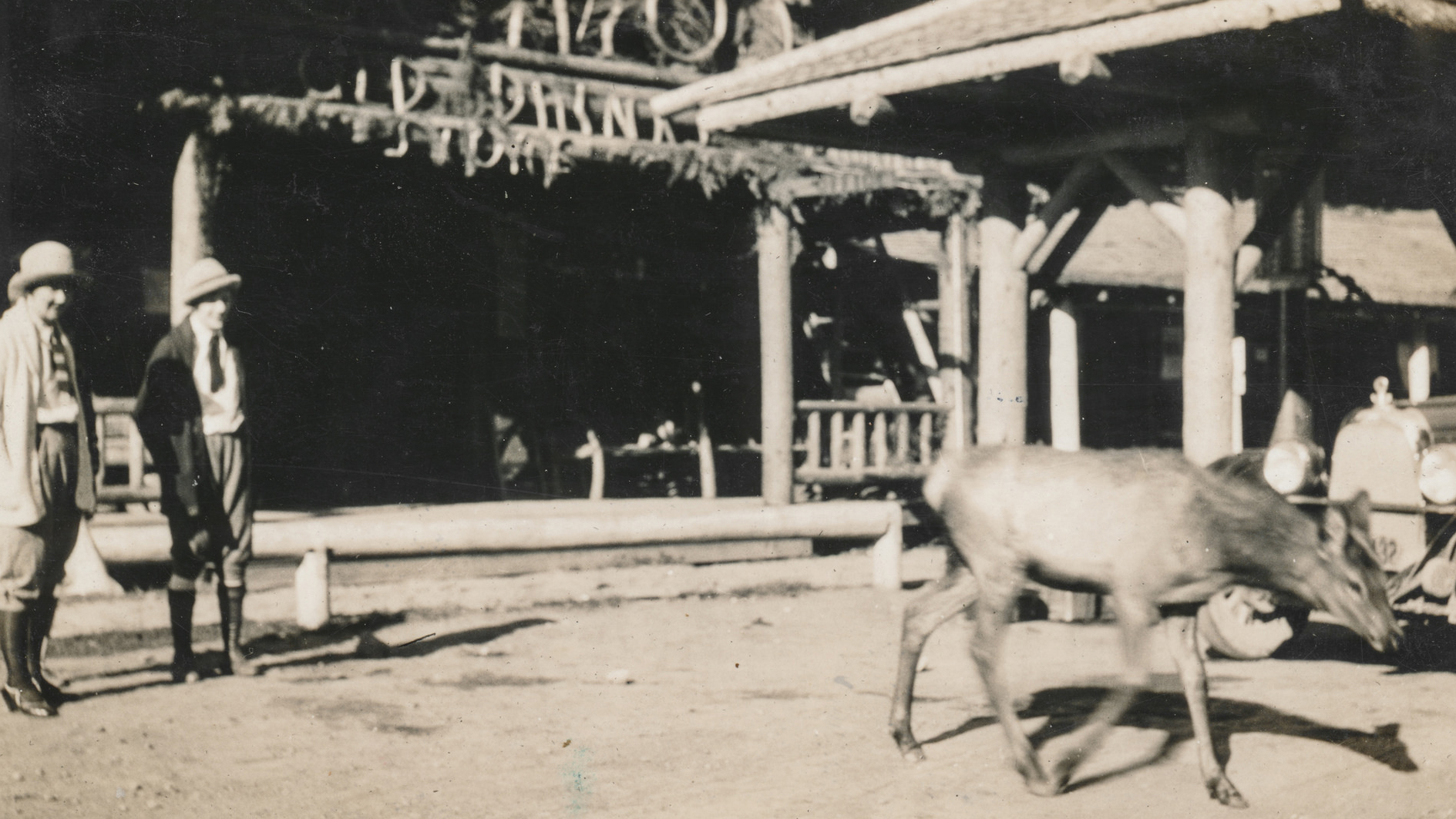
In 1971, Marvin Schrader visited the park on a family vacation and upon getting too close in order to snap a photo with a bison, was gored and thrown 12 feet where he died on the field next to his family.
Then there are the hot springs, so alluring to some yet so potentially deadly. There have been 21 deaths from accidents involving geothermal pools since the park’s opening.
A Billings Gazette editorial from 1970 mentions the death of a child who wandered off the boardwalk and fell into a hot spring. “For all the trappings of man it is wilderness. The man who fails to accept it as such dies,” the editorial bluntly states. “The park is untamed and unfenced wildlife.”
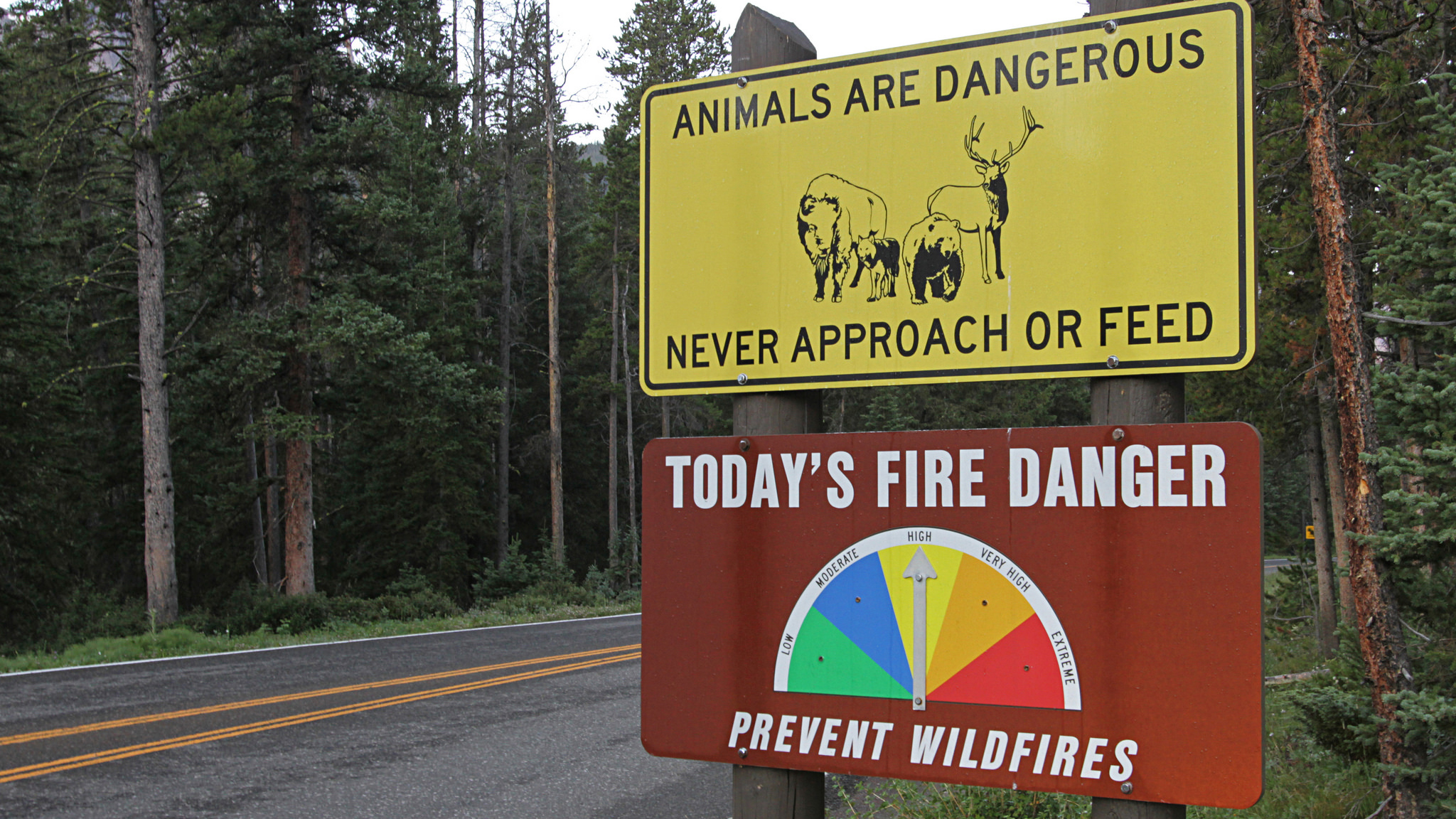
Despite signs posted near boiling hot springs clearly stating “DANGER”, there are numerous other stories of people not heeding these warnings and straying into dangerous territory.
In 1919, a report of a family on vacation illustrates what has happened countless times in the park, with varying degrees of consequences. Captivated by the aqua water of a hot springs, they disregarded the warning signs in an effort to touch it. The husband lost his footing when the brittle ground gave way and plunged into the spring. While he was not lucky enough to survive, hundreds of visitors have come away from similar instances with severe burns covering their bodies.
Data tell us that most visitors to national parks don’t venture from the main roads. This can give the illusion of safety like in a zoo, or theme park. Then, when they see other tourists feeding bears out of their car windows, it’s hard to grasp the brutal realities of nature.
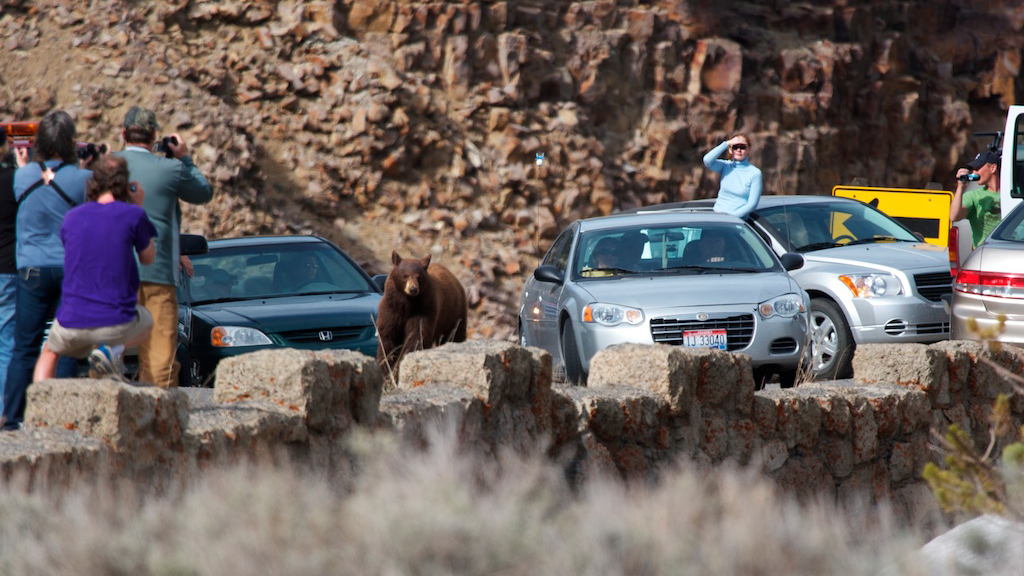
National Geographic’s May 2016 issue on Yellowstone included a photo taken by Jonathan Blair from 1972 of a group of photo-snapping tourists circled much too close around a black bear in an infamous “wildlife jam.” Nothing new here. In the past, it actually was worse with more people legally giving in to bears begging for food.
This contributed to the belief that large carnivores are basically living teddy bears. Sometimes people got away with it, as in the 1970 case of a women placing her small child on the back of a bear while her husband rushed to capture it on camera.
Other times it ended badly. Whittlesey tells the story of two men who set up an illegal campsite near Grand Geyser. After not listening to warnings issued to them, they returned one evening from getting drinks at the Old Faithful Inn, and surprised a grizzly bear who had made a grand feast out of the food they had carelessly left out. The bear charged the men. One ran away in a panic through the thermal area and was lucky that he didn’t fall through into the boiling spring, while the other was mauled by the bear.
The grizzly was tracked down and killed, an all-too-common fate that led to the slogan “a fed bear is a dead bear.” The man’s hair was found in its digestive system. It was determined that this bear had a history of “roadside begging.”
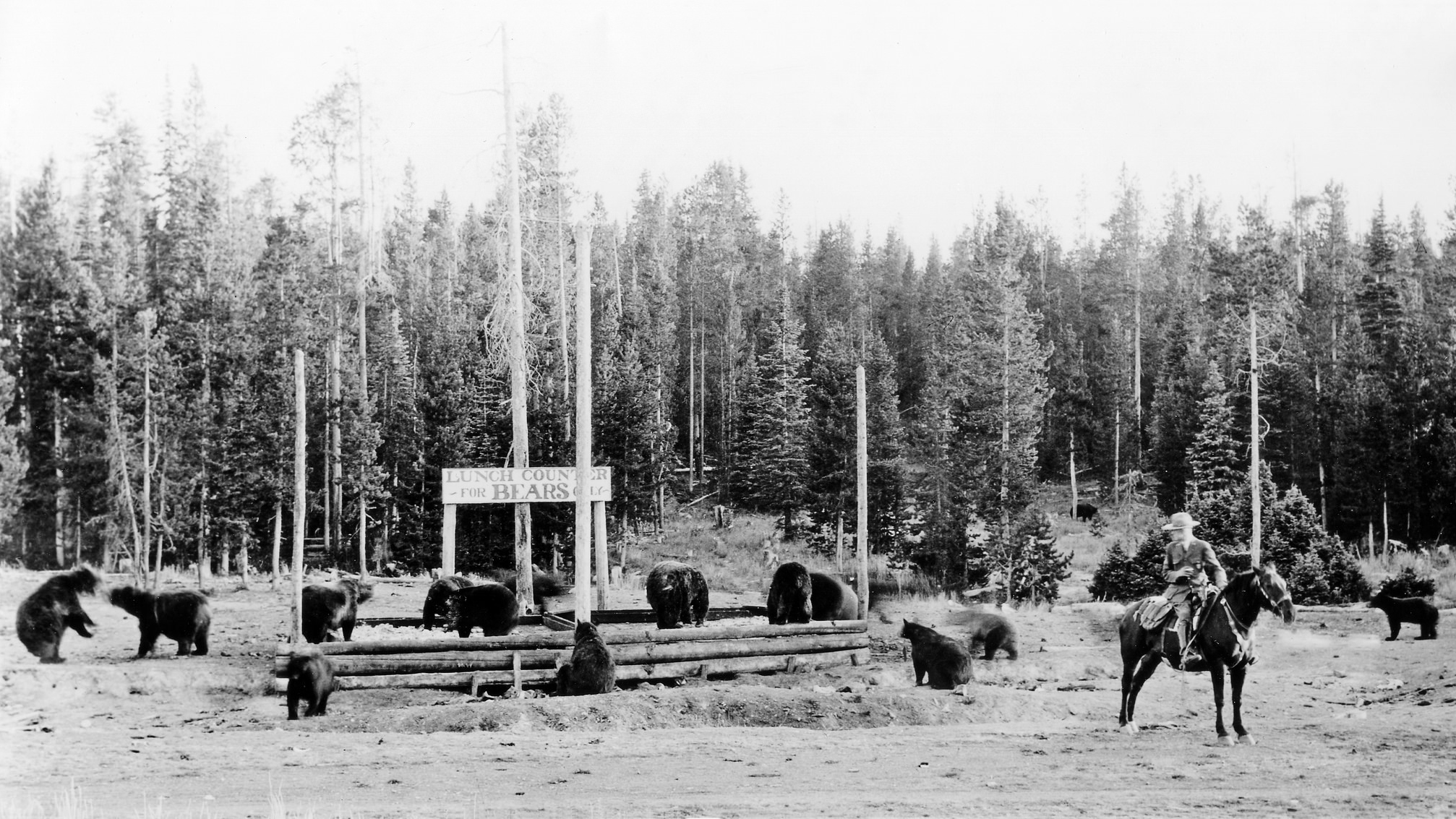
Even the National Park Service got into the bear feeding business. When two large hotels were opened in the park in the late 1800’s, they began simply dumping their garbage outside near the hotel. This attracted bears like bees to honey. In a single year in the 1930s, 115 people were injured by bears near the dumps. In 1902, a man was mauled near a hotel garbage dump while trying to pet a bear. He would have died if it hadn’t been for his wife who clobbered the bear with a club.
National Park Service employees have long confronted people who see parks as Disneyfied nature attractions, sometimes literally. According to a National Geographic article by Todd Wilkinson, in the early 1990’s Wyoming senator Malcolm Wallop visited Yellowstone and actually explored the possibility of erecting monorails in the park modeled after those in Disneyland.
While this may have relieved the problem of “wildlife jams” on highways, it would have heightened the disconnect between visitors and reality.
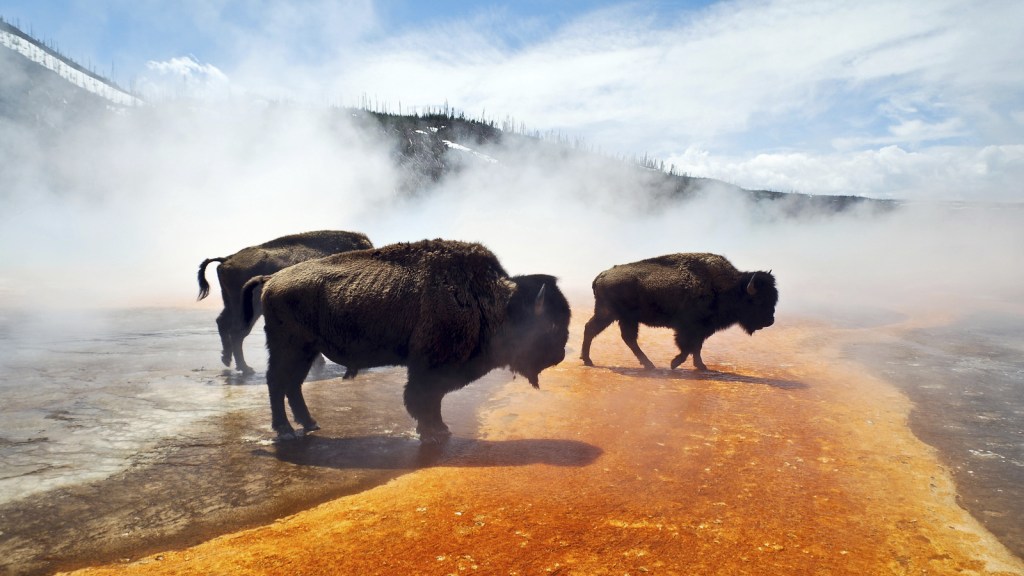



I love our National Parks and have been to most. Yellowston and Glacier aremy favorite and I wish my kids and I could hike more and deeper into the parks but we are easy prey for bears. We hav had a couple of run ins and the bears have scared the hell out of us. In the Applelations we had a cub come out of some brush and try to play with my kids. We had no idea where it’s mother was. We ran out with the little cub chasing us. In one of the National Battlefields in Virginia we had an adult male blackbear parallel our path and our only saving grace was a duck that it heard. We were pretty deep into the park when this occured.
I wish there were ways to hike the parks and be protected from the bears for I would like to see more of the interior. But at the same time perhaps it’s best if we stay away from their area as I would hate for the majority of bears to figure out we are easy prey.
Respect nature and wild animals, people! What is wrong with these people?